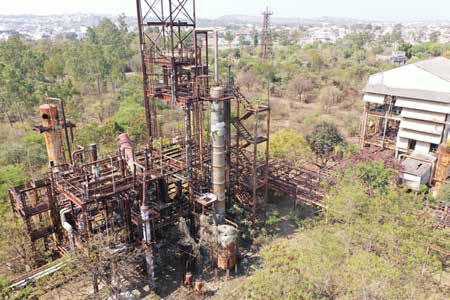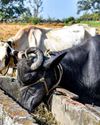Essayer OR - Gratuit
The Enduring Legacy
TerraGreen
|January 2025
The Tale of Bhopal Gas Tragedy Waste Disposal after 40 Years

While the immediate devastation of the gas leak on December 2, 1984, was horrific, the true fury of the Bhopal tragedy unfolded in the years that followed. It wasn't just the toxic gas that claimed lives, but the slow poison that seeped into the earth, contaminating the community's foundation. The aftermath proved worse than anticipated. Union Carbide's hazardous waste caused lingering environmental damage, worsening the health crisis. For years, the government ignored to remove the toxic waste, allowing it to poison the soil and groundwater. This led to a silent epidemic, with rising cancer rates, birth defects, and entire generations affected by the toxins. Long years of vicious conflict, battle and outrage came to a whistling end on January 2,2025, when 337 tonnes of methyl isocyanate waste was ultimately sent for incineration to Pithampur. In this article, Stuti Upadhyay tries to find answer to the question: Why did it take 40 years for any meaningful action to be taken to address the waste left behind by the Bhopal Gas Tragedy?
December 2, 1984, it was in the middle of the night when the city of lakes-Bhopal-experienced a devastating nightmare. A deadly cloud of methyl isocyanate (MIC) gas leaked from the Union Carbide Factory located at a distance of 1 km from Bhopal Railway Station. Long years of vicious conflict, battle and outrage came to a whistling end on January 2, 2025, when 337 tonnes of MIC waste was ultimately sent for incineration to Pithampur. The final chapter of disposal took almost 40 years demarking its epilogue at Pithampur Waste Management Pvt. Limited, just 230 kilometres away from Bhopal city.
Cette histoire est tirée de l'édition January 2025 de TerraGreen.
Abonnez-vous à Magzter GOLD pour accéder à des milliers d'histoires premium sélectionnées et à plus de 9 000 magazines et journaux.
Déjà abonné ? Se connecter
PLUS D'HISTOIRES DE TerraGreen

TerraGreen
Sea Turtles are Doing Well, But Threats Still Loom!
A comprehensive 16-year report by the Dakshin Foundation, IISc, and state forest department
3 mins
May 2025

TerraGreen
Global Plastics Treaty Challenges and Way Forward
In this article, Arvind Kumar discusses the ongoing global efforts to tackle plastic pollution, specifically the negotiations surrounding the Global Plastics Treaty.
8 mins
May 2025
TerraGreen
Back to the Wild Two Greater One-Horned Rhinos Free-Ranged at Dudhwa Tiger Reserve
The Uttar Pradesh Forest Department has reintroduced two more greater one-horned rhinos into the wild at Dudhwa Tiger Reserve. This translocation effort, aimed at establishing free-ranging rhinos and enhancing their population in India's Terai region, was carried out on March 27, 2025, with the support of government officials, field personnel, veterinarians, rhino specialists, and mahouts.
2 mins
May 2025

TerraGreen
A "People's Plan" Launched For Conserving the Biodiversity of Arunachal Pradesh
The \"Arunachal Pradesh State Biodiversity Strategy and Action Plan: People's Plan\" was launched by the Honourable Chief Minister of Arunachal Pradesh, Shri Pema Khandu in Itanagar recently. The Action Plan has been developed by the Arunachal Pradesh Biodiversity Board and WWF-India to guide the state to sustainably utilize its rich biodiversity while ensuring a harmonious balance between development and nature conservation.
2 mins
May 2025

TerraGreen
Striking White Gold! How a Himalayan village found a steady source of income in a basic commodity
Once plagued by the phenomenon of emigration, Rautu ki Beli, a hill village in Uttarakhand, now witnesses its natives returning and making the village their home once again. A major factor behind this homecoming is the livelihood opportunity in the cottage cheese enterprise,Rakesh Agrawal narrates.
3 mins
May 2025

TerraGreen
Way to Upcycle! Parks feature monuments and structures made from upcycled metal scrap
Dinosaurs, Seven Wonders of the World, national icons and monuments stand tall in the nation's capital, New Delhi. Perplexed? Don't fret. Replicas of famous monuments, extinct species and national icons made from scrapped metal junk show how repurposing and upcycling is done, Sarita Brara writes.
5 mins
May 2025

TerraGreen
Reimagining Higher Education towards Sustainable Development in India
This article by Dr Debajit Palit and Dr Anandajit Goswami explores the challenges and opportunities of aligning Indian higher education with the Sustainable Development Goals (SDGs), with particular emphasis on SDG 4 (Quality Education) and SDG 7 (Affordable and Clean Energy).
8 mins
May 2025

TerraGreen
Back to Nature
In a nostalgic return to Jungle Hut in Masinagudi, Dr Marianne Furtado de Nazareth reflects on how the eco-conscious resort has evolved while staying rooted in sustainability.
4 mins
May 2025
TerraGreen
Can Nano-sulphur be a Game Changer for Oilseed Crops? A Case Study from TERI
To achieve edible oil self-sufficiency by 2030, India must boost oilseed productivity. However, declining soil sulphur levels―due to modern farming-are hindering yields, as oilseeds need high sulphur for oil synthesis and seed development. Nanofertilizers like nano-sulphur improve nutrient use, support plant growth, and reduce environmental harm. Replacing 25-50 per cent of traditional fertilizers with nanofertilizers yields results equal to or better than using 100 per cent conventional inputs. TERI has developed nanosulphur using a unique biogenic method, highlight Suneeti Singh, Palash K Manna, Alka Pandey, Maharaj Singh, Rajesh Narayan, Arvind Kapur, and Pushplata Singh.
3 mins
May 2025

TerraGreen
Exposure to Extreme Heat and Cold Temperature Leading to Additional Preventable Deaths in India
The authors of a new 19-year study are calling for immediate measures to curb the growing death toll from extreme temperatures in India. Over the past two decades, heatstroke has caused around 20,000 deaths, while exposure to cold has resulted in an additional 15,000 fatalities.
4 mins
May 2025
